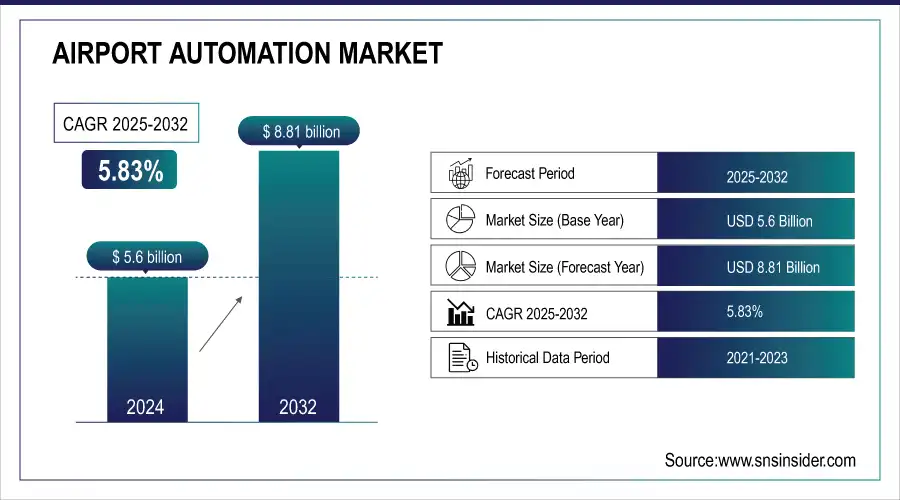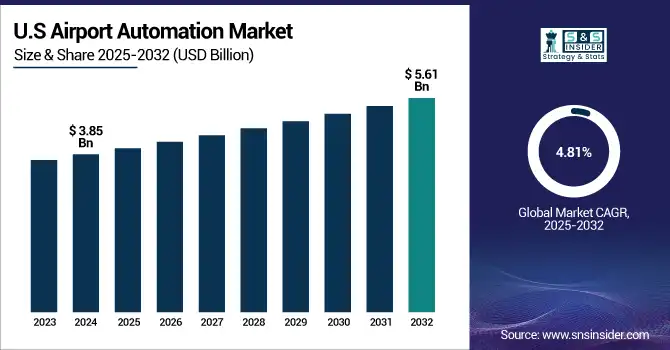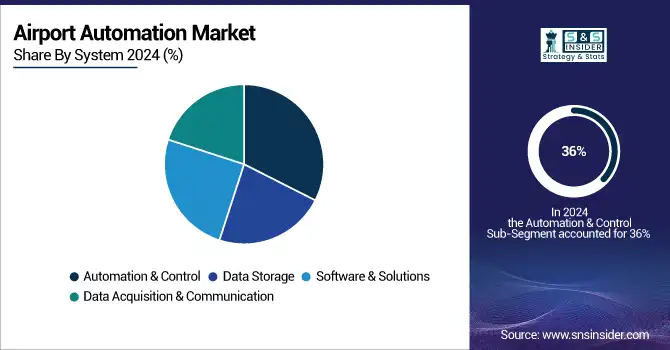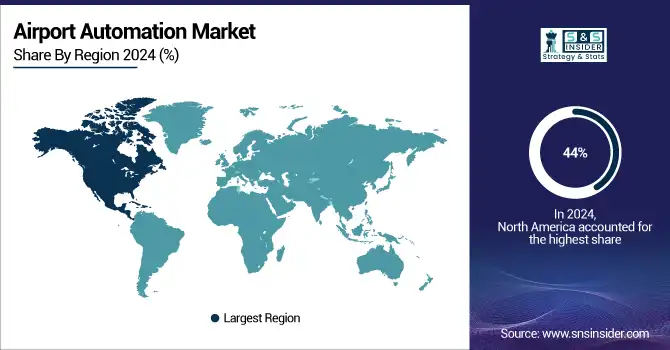Airport Automation Market Size & Trends:
The Airport Automation Market size was valued at USD 5.6 Billion in 2024 and is projected to reach USD 8.81 Billion by 2032, growing at a CAGR of 5.83% during 2025-2032.
The Airport Automation Market growth is driven by the adoption of modern technologies like AI, interactive holograms, autonomous systems, and sensory innovation. Omni-channel communication tools, robotics and data-driven platforms are some of the ways in which airports around the globe are improving their operations and elevating their passengers' experience. The concept of humanizing the automation will take center stage, as digital transformation begins to focus more on smooth and seamless travel with an emotional connection, taking AI beyond predictive maintenance. In this fast-paced episode, we cover how solutions such as chatbot-assisted navigation, autonomous maintenance equipment, and AI-based analytics are evolving traditional airport ecosystems to be more inter-active and self-learning. Moreover, airport is also getting ready for their transformation as an innovation hub, due to inclusion of parallel reality displays, real-time system interoperability and smart infrastructure. This is part of a larger trend towards future-proofed, scalable and passenger-centric automation strategies in global hub airports.

To Get more information on Airport Automation Market - Request Free Sample Report
Miami International Airport (MIA) July 22, 2025 — EI Pharma brings full AI and sense-immersive chatbot-hologram integration to MIA transforming passenger experience with revolutionary use of AI and sensory innovation. World Aviation Festival 2025 Lisbon — Maurice Jenkins on human-centric automation and culture change.
The U.S Airport Automation Market size was valued at USD 3.85 Billion in 2024 and is projected to reach USD 5.61 Billion by 2032, growing at a CAGR of 4.81% during 2025-2032. Airport Automation Market growth is driven by rising air traffic, increasing focus on contactless passenger experience, and strong investments in AI, robotics, and real-time data platforms. Airports are modernizing with advanced baggage handling, security automation, and digital self-service tools. The push toward operational efficiency, sustainability, and improved traveler satisfaction continues to accelerate market adoption across commercial and regional airports.

The Airport Automation Market Trends include the rise of AI-powered passenger assistance systems, integration of biometric verification for seamless check-ins, and deployment of autonomous service robots. Airports are adopting digital twins for predictive maintenance, interactive holograms for customer service, and edge computing for real-time decision-making. There is growing emphasis on modular, upgradable automation platforms and enhanced cybersecurity for operational resilience. These trends reflect a broader shift toward smart, efficient, and passenger-centric airport ecosystems aligned with future-ready digital infrastructure.
Airport Automation Market Dynamics:
Drivers:
-
Rising Demand for Seamless Passenger Experience Driving Airport Automation Adoption
The growing demand for a seamless and intuitive passenger experience is a major driver of the Airport Automation Market. As travelers increasingly expect speed, convenience, and minimal contact, airports are investing in advanced technologies such as AI-powered chatbots, biometric check-ins, autonomous service robots, and interactive holograms. These innovations reduce congestion, improve navigation, and enhance overall satisfaction. In response, airports are modernizing infrastructure to include real-time data systems, digital twins for predictive maintenance, and modular automation platforms. This cause-and-effect relationship between evolving passenger expectations and technological deployment is accelerating the shift toward intelligent, efficient, and passenger-centric airport ecosystems, making automation an essential component of future-ready airport operations.
Advanced Airport Automation, AI assistance, Biometrics & Autonomous Systems will have transformed the passenger journey (July 22) Wayne breaks down how digital twins, interactive holograms, and modular platforms will usher in smart, resilient airport ecosystems.
Restraints:
-
Obstacles Slowing the Growth of Airport Automation Systems
The Airport Automation Market faces several key restraints despite growing demand. High initial capital expenditure for systems like self-service kiosks, biometric gates, and automated baggage handling limits adoption, particularly in small or mid-sized airports. Legacy infrastructure and fragmented systems create integration challenges, increasing costs and project timelines. Strict EU regulations such as GDPR, alongside diverse EMEA country-specific safety and security standards, add compliance complexity. Cybersecurity risks, technological obsolescence, and dependency on skilled personnel further hinder deployment. Labor concerns, budget constraints, and passenger adaptability issues also slow adoption. Collectively, these factors challenge airports in achieving operational efficiency, forcing stakeholders to carefully balance technological advancement with financial, regulatory, and human-resource limitations.
Opportunities:
-
Strategic Digitalization Creating Growth Opportunities in Airport Cargo Automation
Rising global trade complexities and the need for faster, more resilient logistics systems are driving significant opportunities in airport cargo automation. AI-powered cargo processing, digital tracking across the airport process locations and temperature-controlled logistics have improved scalability in airports to manage increased volumes while still addressing sensitive goods like pharmaceuticals and perishables. By adding automation capabilities to its existing API, the platform can be included in larger event-driven systems with various business processes and rules that can use this cause-and-effect dynamic of generating actions based on these state changes to make turnaround times faster, have better visibility and far less human error. With the evolution of global standards for data interoperability and paperless trade, airports that invest in digital infrastructure and automation will emerge as strategic hubs in supply chains which are future-ready.
July 23, 2025 – Changi Airport: Strong Import Demand Swings Changi Airfreight Growth to 6.2% in Q2, with Resilient Cargo Flows Amid Global Trade Headwinds | SINAPPS: The Singapore News Aggregator Supporting that role are strategically positioned investments in automation, digitalisation and network expansion.
Challenges:
-
Legacy Infrastructure and Integration Barriers Hindering Airport Automation Expansion
The expansion of airport automation faces significant challenges due to legacy infrastructure and complex system integration requirements. Many airports still operate on outdated IT frameworks that are incompatible with modern automation technologies such as AI, IoT, and real-time data platforms. This causes delays in implementation and increases the cost and complexity of upgrades. Additionally, integrating diverse systems from multiple vendors often leads to interoperability issues and operational disruptions. As a result, even technologically advanced solutions may underperform or remain underutilized. This cause-and-effect relationship limits the scalability and efficiency of automation efforts, making it difficult for airports to realize the full benefits of smart infrastructure and digital transformation.
Airport Automation Market Segmentation Analysis:
By System
In 2024, the Automation & Control segment accounted for approximately 36% of the Airport Automation market share, expected to be the fastest growth in Airport Automation market over 2025-2032 with a CAGR of 5.83%. The surge is driven by the increasing requirement of autonomous systems to drive operational efficiency, safety, and passenger flow management. Rising installation of AI-enabled control platforms, smart notification screen, and real-time action-taking tools in terminal operations and airside & cargo handling is forcing the AI in Aviation Market. AI/ML is leading to automation which helps airports decrease delays, improve resource utilization and deliver data-powered seamless service experience.

By Technology
In 2024, the Passenger Processing segment accounted for approximately 27% of the Airport Automation market share, owing to rising demand for seamless and contactless travel experiences. Across airports, biometric verification, self-check-in kiosks, e-gates and AI-based assistance systems are being implemented at a rapid pace to improve productivity, reduce waiting time and enhance quality of service for their passengers.
The Automated Ground Handling segment is expected to experience the fastest growth in Airport Automation market over 2025-2032 with a CAGR of 8.04%. This increase is exacerbated by the growing need for optimization in baggage and cargo shipping duration, as well as its security. Ground operations transform with the adoption of autonomous vehicles, robotic loaders and smart logistics systems providing 24/7 reliability.
By Application
In 2024, the Terminal-side Operations accounted for approximately 41% of the Airport Automation market share, driven by increasing automation in passenger check-in, baggage handling, and security screening. Growing emphasis on improving throughput, minimizing delays, and enhancing the passenger experience is fueling adoption of smart kiosks, automated lanes, and integrated control systems within terminals.
The Airside Operations segment is expected to experience the fastest growth in Airport Automation market over 2025-2032 with a CAGR of 6.11%. This growth is driven by increasing adoption of automated aircraft guidance systems, real-time airside surveillance, and autonomous ground support equipment. Airports are investing in smart airside technologies to improve safety, reduce delays, and streamline aircraft turnaround processes, enhancing overall operational efficiency.
By End-User
In 2024, the Commercial Airports accounted for approximately 53% of the Airport Automation market share, expected to experience the fastest growth in Airport Automation market over 2025-2032 with a CAGR of 6.91% This surge is fueled by rising air passenger traffic, increasing demand for seamless travel experiences, and widespread deployment of biometric systems, automated check-ins, and smart security lanes. Commercial airports are prioritizing automation to handle higher volumes efficiently, reduce operational costs, and enhance service quality making them central to digital transformation across the global aviation ecosystem.
Airport Automation Market Regional Insights:
In 2024 North America dominated the Airport Automation market and accounted for 44% of revenue share, driven by increasing air traffic, rising acceptance of modernized technologies especially robotics solutions across airports and expanding investments related to smart airport infrastructure. The region has an advantage from domination by established players, forward-leaning regulatory frameworks and the persistent demand for more integrated passenger journeys.

Get Customized Report as per Your Business Requirement - Enquiry Now
Asia-Pacific is expected to witness the fastest growth in the Airport Automation market over 2025-2032, with a projected CAGR of 7.48%, on the back of rapid airport infrastructure development, increasing air passenger traffic and rising government investments into smart airport initiatives. This growth trajectory is supported by the regional pivot on digital transformation, especially in emerging economies such as India and Southeast Asia.
In 2024, Europe emerged as a promising region in the Airport Automation market, due to strong regulatory support, robust aviation infrastructure, and rising demand for seamless passenger experiences. Major airports across Germany, France, and the UK are investing in advanced automation technologies such as biometric verification, smart baggage handling, and AI-driven traffic management.
Latin America (LATAM) and the Middle East & Africa (MEA) regions are witnessing steady growth in the Airport Automation market, growing steadily due to continued airport modernization projects, higher air travel demand and government investments in a smart infrastructure. Nations including Brazil, UAE, and Saudi Arabia are concentrating on improving the passenger experience as well reducing operational costs with leveraged deployment of automation devices such as kiosks and check-in systems, biometrics adoption for seamless service delivery, smart ground handling technology. These efforts are slowly filling infrastructure holes and signing regional airports at the same step to be aligned with digital aviation excellence worldwide.
Airport Automation Companies are:
The Key Players in Airport Automation Market included are Daifuku Co. Ltd., Collins Aerospace, Siemens AG, Amadeus IT Group, SITA, Honeywell International Inc., Thales Group, Indra Sistemas S.A., Vanderlande Industries, NEC Corporation, Bosch Security Systems, TAV Technologies, Inform GmbH, Raytheon Technologies, Huawei Technologies, IBM Corporation, ADB Safegate, Alstef Group, Embross Group, Beumer Group. and Others.
Recent Developments:
-
In Feb 2024, Daifuku has unified its North American branding, renaming subsidiaries like Jervis B. Webb Company to Daifuku Airport America Corporation and Elite Line Services to Daifuku Services America Corporation. The move reflects a global standardization effort to strengthen identity and streamline operations across regions.
-
In Jul 2025, Thales has been selected by Finland’s VTT to supply its TopSky – AstraUTM system for the U-Space Finland pilot, enabling safe, automated drone traffic management. The initiative supports real-time UAV integration, boosting Finland’s position in airspace innovation under EU regulations.
| Report Attributes | Details |
|---|---|
| Market Size in 2024 | USD 5.6 Billion |
| Market Size by 2032 | USD 8.81 Billion |
| CAGR | CAGR of 5.83% From 2025 to 2032 |
| Base Year | 2024 |
| Forecast Period | 2025-2032 |
| Historical Data | 2021-2023 |
| Report Scope & Coverage | Market Size, Segments Analysis, Competitive Landscape, Regional Analysis, DROC & SWOT Analysis, Forecast Outlook |
| Key Segments | • By System (Data Storage, Automation & Control, Data Acquisition & Communication and Software & Solutions) • By Technology (Baggage Handling Systems, Passenger Processing, Security Systems, Air Traffic Management (ATM), IT Solutions and Automated Ground Handling) • By Application (Terminal-side Operations, Airside Operations and Landside Operations) • By End-User (Commercial Airports, Military Airports, Cargo Airports and Private/Regional Airports) |
| Regional Analysis/Coverage | North America (US, Canada), Europe (Germany, UK, France, Italy, Spain, Russia, Poland, Rest of Europe), Asia Pacific (China, India, Japan, South Korea, Australia, ASEAN Countries, Rest of Asia Pacific), Middle East & Africa (UAE, Saudi Arabia, Qatar, South Africa, Rest of Middle East & Africa), Latin America (Brazil, Argentina, Mexico, Colombia, Rest of Latin America). |
| Company Profiles | The Airport Automation Market Companies include Daifuku Co. Ltd., Collins Aerospace, Siemens AG, Amadeus IT Group, SITA, Honeywell International Inc., Thales Group, Indra Sistemas S.A., Vanderlande Industries, NEC Corporation, Bosch Security Systems, TAV Technologies, Inform GmbH, Raytheon Technologies, Huawei Technologies, IBM Corporation, ADB Safegate, Alstef Group, Embross Group, Beumer Group. and Others. |

